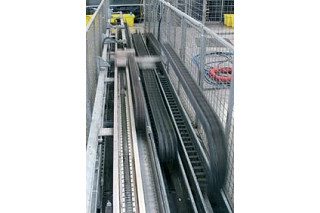Change Language :
Example 3: tested, tested, tested! "Million double stroke" in the energy chain

Profibus cables in permanent industrial use
For the user, the cable market is almost impossible to keep track of. Competition between cable suppliers is increasing and the various manufacturers are outdoing each other in their "guaranteed service life" claims for cables in energy chain applications. Catalogues talk about ten million or even 50 million double strokes (DH) - it's all about the service life of cable in moving applications.
A closer look at the figures mentioned often leaves open the question of how or how realistically (examples: length of travel, test radii, etc.) tests were carried out in order to guarantee these stroke rates. Information that cables are tested in accordance with VDE 0472, part 603 test type H, is also not helpful for determining the service life in energy supply chains, as the roller test bench cannot provide any information and the aforementioned VDE standard is not a test manual for special cables in energy supply chains.
Differences in service life
At the beginning of 2002, igus®'s own test laboratory therefore commissioned a fundamental study on the subject of "the service life of Profibus cables in real applications". The aim was to investigate possible differences in service life between the chainflex® cable CFBUS.001 from igus® and a Profibus cable from a market leader. The test parameters required for this were selected on the basis of the competitor's catalogue data:
(Test parameters according to the competitor's catalogue data)
| Catalogue details | Test specimen "A" Two-wire Profibus cable | Test specimen "B" igus® chainflex® CFBUS.001 |
|---|---|---|
| Cross section | (2xAWG24)C | (2 x 0.25 mm2)C |
| Guaranteed life expectancy | min. 4.0 million Cycles | Determine in an attempt to |
| Bend radius | > = 60 mm | 85mm |
| Diameter | 8.0 mm | 8.5 mm |
| Catalogue data | trade show stand 2002 | trade show stand 2002 |
A sensible test setup for this cable is always a gliding application, as Profibus systems are used here due to their data security, especially for longer travel distances and longer transmission paths.
To enable non-destructive testing and thus achieve a large number of bending cycles in a short time, a real Profibus transmission line was specially constructed. A Profibus master plug-in card is located in a PC at the fixed end of the test chain. The cables to be analysed are used to establish a connection to a Profibus slave located at the moving end. This allows the transmission rate to be defined using a diagnostic programme. Data packets that may have been transmitted incorrectly can be displayed. The highest possible transmission rate of 12 Mbit/s was set.
The basic investigation started at the beginning of 2002, which is still continuing today, led to a total failure of the test specimen "A" after a comparatively low number of strokes of only 420,000 DH, which according to catalogue specifications should function reliably for at least 4.0 million cycles. This means that the service life actually achieved deviates from the catalogue values by a factor of 10.
In contrast, the test specimen "B", the CFBUS.001, is still being tested without faulty data transmissions. In the meantime, over 14.0 million double strokes have been achieved.
Design and materials
The main reasons for the considerable difference in service life are the different design parameters between the test specimen "A" and the test specimen "B" (CFBUS.001), as well as the different materials used in the design of the cable. The core insulation of the bus consists of a foamed material in all test specimens. Its favourable electrical specifications ensure that the transmission properties specified by the standard are achieved. However, one disadvantage of this material is its unfavourable mechanical flexural fatigue strength. The forces acting on the bus pair during bending should be absorbed by the element sheath in order to relieve the mechanical stress of the core insulation.
Highly elastic element casing
The test specimen "B" (igus®) was therefore provided with a mechanically high-quality, extruded TPE inner or element jacket gusset-filling in order to protect the bus pair from mechanical influences during the bending process. The element jacket must be highly elastic. A mechanically inferior element jacket made of inexpensive fillers - just like fillers or banding, which are frequently used in many other design principles - only serves to round the bus pair. However, it is not able to protect it from the high mechanical load in the chain. Tensile and compression forces occurring within the cable ultimately act on the core particularly at those points where the element sheath is broken.
| Test parameters | |
|---|---|
| Travel: | S = 5.0 m |
| Speed approx: | V = 3.5 m/s |
| Acceleration approx: | a = 7.5 m/s2 |
| Radius approx: | 55 mm |
The design of the test specimen "B" (CFBUS.001) is characterised by a mechanically high-quality, gusset-filling TPE element casing. It mechanically relieves the bus pair, fixes the core in a defined position and rounds it off.
Furthermore, the extremely short lay lengths of the core and the special conductors ensure that no high tensile or compression stresses act on a long core length. This means that relatively low bend radiuses can be realised with high numbers of cycles.
New: UL and CSA approval
chainflex® CFBUS cables are now also available with UL and CSA approval and are DESINA-compliant for all common fieldbus systems. The highly abrasion-resistant, flame-retardant TPE outer jacket is extruded at high pressure onto the braided overall shield, which is manufactured with a coordinated braid angle to provide additional stabilisation for the cable.
The bus elements, which are stranded with a particularly short pitch length, are protected by a gusset-filling extruded TPE inner jacket and fulfil the required bus parameters thanks to the selection of coordinated insulating materials and manufacturing processes.
Like all chainflex®cables, the new CFBUS series is now available from stock without cutting costs or minimum quantity surcharges for all common fieldbuses.
More information about chainflex® cable
Consulting
I look forward to answering your questions

Katharina Wielpütz+49 2203 9649 7082Write e-mail
Shipping and consultation
In person:
Monday to Friday from 7 am - 8 pm.
Saturdays from 8 am- 12 pm.
Online:
24h
WhatsApp-Service:
Montag – Freitag: 8 – 16 Uhr

